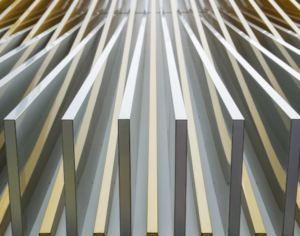In cafes, the way they look is super important because it affects how people feel when they’re there. Everything from the wood panelling to the metal finishes plays a role. Even the way the cafe was built, like with bubble cranes and slab cranes, can change how it feels to be inside. This article is all about how the design of a cafe can create an experience that people love and remember.
Understanding Interior Design Styles
It’s important to know different interior design styles to make a great cafe. Industrial style is all about the raw and rugged look with unfinished elements like brick and metal. Minimalist design is simple, functional, and has clean lines with neutral colours for a peaceful and uncluttered atmosphere. Rustic design draws from nature using natural materials like wood and stone and vintage accents to create a warm and welcoming vibe. Modern design has sleek lines and cutting-edge technology for a contemporary and dynamic look. Each style has its unique aesthetic and mood, so cafe owners can pick the one that suits their brand and audience. By understanding these styles, designers can create cafe interiors that look cohesive and visually appealing, leaving a lasting impression on customers.
Incorporating Materials
Incorporating materials such as timber battens and aluminium cladding plays a crucial role in shaping the ambience and style of cafe interiors. With their natural warmth and texture, timber battens add a sense of rustic charm and cosiness to the space. They can be used for wall panelling, ceiling treatments, or even as decorative elements, infusing the cafe with authenticity and craftsmanship. On the other hand, aluminium cladding offers a sleek and modern aesthetic with its clean lines and reflective surfaces. It can be used for exterior facades, accent walls, or furniture pieces, imparting a contemporary and industrial vibe. By judiciously incorporating these materials into the design scheme, cafe owners can create dynamic and visually exciting interiors that capture the attention of patrons and enhance their dining experience.

Impact of Construction Techniques
The impact of construction techniques like bubble and slab cranes extends beyond mere structural considerations, profoundly influencing the design and layout of cafes. With their ability to navigate tight spaces and reach great heights, a bubble crane offers architects and designers more flexibility in creating innovative and dynamic architectural forms. This can result in unique building shapes and layouts that maximise available space and create memorable dining experiences for patrons. Similarly, slab cranes facilitate the efficient installation of large concrete slabs, allowing for faster construction times and reduced costs. This efficiency in construction can translate into more streamlined layouts and spatial designs for cafes, enabling owners to optimise floor plans and create functional and inviting environments for customers. By leveraging these advanced construction techniques, cafe designers can push the boundaries of creativity and deliver aesthetically pleasing and operationally efficient spaces.
Adaptation and Innovation
Interior design styles in cafes constantly evolve and adapt to meet changing trends and customer preferences. Innovative approaches emerge in cafe interior design as societal values shift towards sustainability and environmental consciousness. Designers increasingly incorporate sustainable materials such as reclaimed wood, bamboo, and recycled metal into their projects. These materials reduce ecological impact and add unique textures and character to cafe spaces. Furthermore, there’s a growing emphasis on utilising eco-friendly construction methods, such as modular construction and passive design principles, to minimise energy consumption and waste generation.
Technology plays a significant role in modern cafe design, with features like intelligent lighting, digital menu boards, and contactless payment systems becoming increasingly prevalent. By staying abreast of emerging trends and leveraging innovative techniques, cafe designers can create spaces that meet the needs of today’s consumers and anticipate the demands of tomorrow’s sustainable lifestyle.
Creating Memorable Experiences
Creating memorable dining experiences for cafe patrons hinges upon a cohesive interior design that harmonises aesthetics with functionality. A well-designed cafe appeals to the senses and cultivates a welcoming atmosphere conducive to social interaction and relaxation. From the layout of seating arrangements to the choice of lighting and decor, every element contributes to the overall ambience and customer experience.
Moreover, design extends beyond mere aesthetics; it plays a pivotal role in attracting customers and fostering loyalty. A thoughtfully designed cafe distinguishes itself from competitors, leaving a lasting impression on patrons and encouraging them to return. Whether it’s the cosy nooks for intimate conversations, the inviting communal tables for social gatherings, or the strategically placed plants that add a touch of greenery, each design element contributes to the overall narrative of the cafe.
Furthermore, a cohesive interior design reflects the cafe’s brand identity and values, resonating with customers on a deeper level. Cafe owners can forge meaningful connections with their clientele by creating spaces that evoke emotions and tell stories, turning casual visitors into loyal patrons who return for the food, drinks and experience. Ultimately, the success of a cafe hinges upon its ability to craft memorable moments through thoughtful and cohesive interior design.
To sum up, interior design styles profoundly shape the ambience and experience of cafe spaces, from the choice of materials to construction techniques and beyond. Thoughtful design choices are pivotal in crafting inviting and distinctive environments that captivate patrons and foster loyalty. Whether creating or renovating cafe spaces, it’s essential to consider the impact of design on the overall dining experience. By embracing innovative approaches and staying attuned to customer preferences, cafe owners can create memorable and immersive spaces that leave a lasting impression on visitors, ensuring the success and longevity of their establishments in the competitive hospitality landscape.
